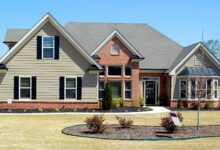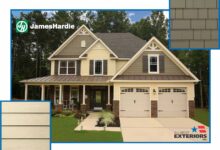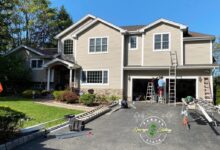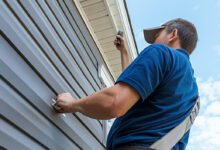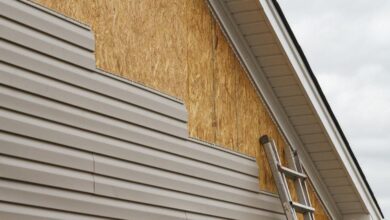Siding Replacement: A Comprehensive Guide
Siding replacement is a significant home improvement project impacting both aesthetics and property value. This guide explores the various siding options available, from classic wood to modern composite materials, detailing the advantages and disadvantages of each. We’ll navigate the entire process, from choosing the right contractor to maintaining your new siding for years to come, ensuring a smooth and successful renovation.
Understanding the intricacies of siding replacement involves careful consideration of material choices, cost analysis, and contractor selection. This comprehensive overview aims to equip homeowners with the knowledge necessary to make informed decisions throughout each stage of the project, ultimately achieving a beautiful and durable exterior.
Types of Siding
Choosing the right siding for your home is a significant decision impacting both aesthetics and longevity. Several materials offer distinct advantages and disadvantages, influencing factors like cost, maintenance, and environmental impact. Understanding these differences is crucial for making an informed choice.
Vinyl Siding
Vinyl siding is a popular choice due to its affordability and low maintenance. It’s manufactured from polyvinyl chloride (PVC), a plastic polymer. Its advantages include resistance to rot, insect infestation, and moisture damage. It’s also relatively easy to install and comes in a wide variety of colors and styles, mimicking the look of wood or other materials. However, vinyl siding can be susceptible to damage from impact, and extreme temperature fluctuations can cause it to expand and contract, potentially leading to cracking or warping. Furthermore, it’s not as durable as some other options and may fade over time. From an environmental perspective, the production of PVC involves the use of energy and releases greenhouse gases. Disposal can also be challenging, as vinyl isn’t readily biodegradable.
Wood Siding
Wood siding offers a classic, natural look and excellent insulation properties. Various wood types, such as cedar, redwood, and pine, are used, each with its own characteristics regarding durability and resistance to rot. Properly maintained wood siding can last for decades, offering a timeless aesthetic appeal. However, wood siding requires significant maintenance, including regular painting or staining to protect it from the elements and prevent rot or insect damage. It’s also susceptible to moisture damage and can be more expensive than vinyl siding. Environmentally, wood siding is a renewable resource, but its production and transportation still have an environmental footprint. The use of sustainably harvested wood is crucial to minimize its impact.
Fiber Cement Siding
Fiber cement siding combines cement, cellulose fibers, and other additives to create a durable, low-maintenance material. It offers excellent resistance to fire, rot, insects, and moisture damage. Fiber cement siding is also very strong and can withstand impacts better than vinyl siding. However, it’s more expensive than vinyl and can be more challenging to install. It’s also heavier than vinyl or wood, requiring stronger framing. Environmentally, fiber cement siding has a lower carbon footprint than vinyl, but its manufacturing process still involves energy consumption and the release of some emissions. Proper disposal is also important.
Metal Siding
Metal siding, typically made from aluminum or steel, is highly durable and resistant to fire, rot, insects, and moisture damage. It requires minimal maintenance and offers a long lifespan. Metal siding is also available in a variety of colors and styles. However, it can be more expensive than vinyl or wood and may dent or scratch more easily. It can also be noisy during rain or hail. From an environmental perspective, metal siding is highly recyclable, making it a relatively sustainable option. However, the manufacturing process still involves energy consumption and the release of emissions.
Siding Material Comparison
| Siding Type | Lifespan (Years) | Cost (Relative) | Maintenance | Aesthetic Appeal |
|---|---|---|---|---|
| Vinyl | 20-40 | Low | Low | Moderate; variety of styles available |
| Wood | 30-50+ (with proper maintenance) | Medium-High | High | High; classic and natural look |
| Fiber Cement | 50+ | Medium-High | Low | Moderate; can mimic other materials |
| Metal | 50+ | High | Very Low | Moderate; modern and clean look |
Siding Replacement Process
Replacing your home’s siding is a significant undertaking, impacting both the aesthetics and the structural integrity of your property. A well-executed project will enhance curb appeal and protect your home for years to come. Understanding the process ensures a smooth and successful renovation.
The siding replacement process typically involves several key stages, from the initial assessment to the final cleanup. Each stage requires careful planning and execution to achieve optimal results. Proper preparation and attention to detail are crucial to minimize disruptions and ensure a high-quality finish.
Project Planning and Consultation
The initial phase involves a thorough assessment of your existing siding and a discussion of your preferences. This includes identifying the type of siding, assessing its condition, and determining the scope of the replacement. A detailed estimate will be provided, outlining materials, labor costs, and project timelines. This consultation also allows for the selection of new siding materials and colors to match your home’s style and your personal preferences.
Siding Removal and Preparation
This stage focuses on the careful removal of the old siding. Workers will begin by removing any existing trim, flashing, and accessories around windows and doors. They then carefully remove the old siding panels, paying attention to not damage the underlying sheathing or house wrap. Any damaged areas of the sheathing or house wrap are repaired or replaced at this time. This image depicts workers systematically removing siding panels, starting from the top and working their way down, carefully stacking the removed panels for disposal or recycling. The workers are wearing safety gear including hard hats and safety glasses.
New Siding Installation
With the surface prepared, the installation of the new siding begins. This typically starts at the bottom of the house and works upwards, ensuring proper overlapping and alignment of panels. The installation process adheres to manufacturer’s instructions to ensure a watertight and durable exterior. This step includes installing any new trim, flashing, and accessories. This image shows a close-up of a worker carefully installing a siding panel, ensuring proper alignment and fastening. The worker uses a level to ensure straight lines and utilizes specialized tools for precise fastening.
Potential Challenges and Mitigation Strategies
Several challenges can arise during siding replacement. These include unforeseen damage to the underlying structure, issues with moisture penetration, and difficulties matching existing materials. Addressing these challenges requires experience and expertise. For instance, discovering rotted sheathing necessitates repair or replacement before new siding can be installed. Moisture issues may require additional waterproofing measures. Difficulties matching existing materials might require sourcing specific materials or adjusting the design slightly. This requires careful planning and potentially the expertise of specialized contractors.
Final Cleanup and Inspection
Once the new siding is installed, a thorough cleanup is conducted. This includes removing debris, disposing of old materials responsibly, and ensuring the surrounding area is left clean and tidy. A final inspection is performed to verify that the installation meets all standards and expectations. This includes checking for proper alignment, water tightness, and overall aesthetic appeal. This image shows a completed siding project, highlighting the neat and clean finish. The new siding looks fresh and the entire exterior looks updated and improved.
Cost Considerations
Replacing your siding is a significant investment, and understanding the cost factors is crucial for budgeting and planning. Several key elements contribute to the overall expense, ranging from material selection to labor and permitting fees. A well-informed approach ensures a smooth and financially manageable project.
The total cost of siding replacement is a multifaceted calculation. It’s not simply the price of the materials; labor, permits, and unforeseen complications all play a significant role. Understanding these components allows for accurate budgeting and prevents unexpected financial strain during the project.
Factors Influencing Siding Replacement Costs
Several factors significantly impact the final cost of a siding replacement project. These factors should be carefully considered during the planning phase to create a realistic budget.
- Material Costs: The type of siding you choose dramatically affects the price. Vinyl siding is generally the most affordable, while fiber cement and wood siding are considerably more expensive. The cost also varies based on the quality and features of the material (e.g., thickness, texture, color).
- Labor Costs: Labor costs are a substantial portion of the overall expense. The size and complexity of your home, as well as the accessibility of the area, influence the number of labor hours required. Experienced and reputable contractors often command higher hourly rates.
- Permits and Inspections: Obtaining necessary building permits and scheduling inspections adds to the project’s cost. Permit fees vary depending on your location and the scope of the work. Inspections ensure the work meets local building codes and safety standards.
- Preparation and Removal of Existing Siding: The condition of your existing siding influences the cost of removal. Damaged or difficult-to-remove siding may require more labor and time, increasing the overall expense.
- Additional Services: Costs may increase if additional services are needed, such as repairs to underlying sheathing, window and door trim replacement, or insulation upgrades. These should be factored into the initial budget.
Cost Estimates for Different Siding Types and Project Sizes
The following table provides estimated costs for different siding types and project sizes. These are averages and can vary significantly based on location, contractor, and project specifics. It’s crucial to obtain multiple quotes from reputable contractors for a personalized cost estimate.
| Siding Type | Small Home (1,000 sq ft) | Medium Home (1,500 sq ft) | Large Home (2,000 sq ft) |
|---|---|---|---|
| Vinyl | $5,000 – $10,000 | $7,500 – $15,000 | $10,000 – $20,000 |
| Fiber Cement | $10,000 – $20,000 | $15,000 – $30,000 | $20,000 – $40,000 |
| Wood | $15,000 – $30,000 | $22,500 – $45,000 | $30,000 – $60,000 |
Financing Options for Siding Replacement
Several financing options are available to homeowners for managing the costs of siding replacement. These options can make a large project more manageable.
- Home Equity Loans or Lines of Credit (HELOC): These loans use your home’s equity as collateral. They offer relatively low interest rates, but require good credit and sufficient equity.
- Personal Loans: Personal loans can be obtained from banks or credit unions. Interest rates vary depending on creditworthiness. They offer flexibility but may have higher interest rates than home equity loans.
- Contractor Financing: Some contractors offer financing options directly to customers, often with manageable payment plans. However, carefully review the terms and interest rates before committing.
- Credit Cards: While offering convenience, credit cards typically have high interest rates and should be used cautiously, especially for large projects. Only use this option if you can pay off the balance promptly.
Choosing a Contractor
Selecting the right siding contractor is crucial for a successful and long-lasting siding replacement project. A poorly chosen contractor can lead to subpar workmanship, cost overruns, and significant headaches. Therefore, thorough research and careful consideration are essential steps in the process.
Finding Reputable and Qualified Siding Contractors
Several avenues exist for locating qualified siding contractors. Online directories, such as those provided by the Better Business Bureau or Angie’s List, offer reviews and ratings from past clients. Local home improvement stores and building supply centers often maintain lists of contractors they work with, providing a degree of pre-screening. Networking with friends, family, and neighbors can also yield valuable recommendations. Remember to always verify the credentials and insurance of any contractor you are considering, regardless of the method used to find them.
Checklist of Questions for Potential Contractors
Before committing to a contractor, a comprehensive list of questions should be addressed. This ensures that you fully understand their qualifications, experience, and the specifics of their proposed work.
- Licensing and insurance verification: Confirm that the contractor possesses the necessary licenses and carries adequate liability and workers’ compensation insurance.
- Experience and expertise in siding installation: Inquire about the contractor’s years of experience specifically with siding installation, and the types of siding they have worked with previously. Request examples of their previous work, including photos or addresses of completed projects.
- Detailed project plan and timeline: Obtain a detailed written proposal outlining the scope of work, materials to be used, and a realistic project timeline.
- Payment schedule and terms: Clarify the payment schedule, ensuring that payments are aligned with project milestones and not paid upfront in full.
- Warranty information: Inquire about the warranty offered on both labor and materials, ensuring it’s comprehensive and clearly defined.
- References from past clients: Request contact information for several past clients to obtain firsthand feedback on the contractor’s work ethic and professionalism.
- Permits and inspections: Confirm the contractor’s responsibility for obtaining necessary permits and scheduling inspections.
Contractor Selection Methods: Verification and Insurance
Several methods exist for selecting a contractor, each carrying varying degrees of reliability. Direct referrals from trusted sources often provide a higher degree of confidence, but independent research remains crucial. Online searches can uncover a wider range of options, but careful vetting is essential to filter out unqualified or unreliable contractors. Regardless of the method, verifying a contractor’s license, insurance coverage, and obtaining references are paramount steps. Confirming that the contractor carries adequate liability insurance protects you from potential financial losses due to accidents or damages during the project. Similarly, verifying workers’ compensation insurance safeguards you from liability if a worker is injured on your property. A contractor lacking proper insurance presents significant risk.
Maintenance and Longevity
Proper siding maintenance significantly extends the lifespan of your home’s exterior, protecting it from the elements and preserving its aesthetic appeal. Regular cleaning and prompt attention to minor issues can prevent costly repairs down the line, ensuring your investment remains valuable for years to come. This section details maintenance strategies for various siding types and addresses common problems.
Siding Material Maintenance Guide
Different siding materials require specific care. Understanding these nuances is crucial for effective maintenance. Ignoring material-specific needs can lead to premature deterioration and costly replacements.
- Vinyl Siding: Vinyl is relatively low-maintenance. Regular cleaning with a hose and mild detergent removes dirt and grime. Avoid abrasive cleaners or power washers that can damage the surface. Inspect for cracks or damage, and repair or replace damaged sections promptly.
- Wood Siding: Wood siding requires more frequent maintenance than vinyl. Regularly inspect for signs of rot, insect infestation, and damage. Apply a high-quality wood sealant every 2-3 years to protect against moisture damage. Clean with a soft brush and mild detergent, avoiding harsh chemicals.
- Fiber Cement Siding: Fiber cement is durable and requires minimal maintenance. Regular cleaning with a hose and mild detergent is sufficient. Inspect for cracks or damage and repair as needed. Unlike wood, it does not require sealant application.
- Aluminum Siding: Aluminum siding is exceptionally durable and low-maintenance. Regular cleaning with soap and water is generally all that is needed. Inspect for dents or scratches, and repair or replace as necessary. Aluminum’s resistance to rot and insect damage makes it a long-lasting option.
Maintenance Schedule
A proactive maintenance schedule ensures your siding remains in optimal condition. The frequency of tasks varies depending on your climate and siding type.
| Task | Frequency | Notes |
|---|---|---|
| Cleaning (all siding types) | Twice yearly (spring and fall) | Use a hose and mild detergent. Avoid harsh chemicals and high-pressure washing. |
| Inspection (all siding types) | Annually | Check for damage, cracks, loose panels, or signs of insect infestation. |
| Wood sealant application (wood siding) | Every 2-3 years | Use a high-quality exterior wood sealant. |
| Caulk replacement (all siding types) | As needed | Replace cracked or deteriorated caulking around windows and doors. |
Common Siding Problems and Solutions
Early identification and prompt action are key to preventing minor siding issues from escalating into major, costly repairs. Recognizing common problems allows for timely intervention.
- Cracks and Holes: Small cracks can be filled with caulk, while larger holes may require patching or replacement of the affected siding panel. Prompt repair prevents water infiltration.
- Loose or Damaged Panels: Loose panels should be secured immediately to prevent further damage. Damaged panels often require replacement. This prevents water damage and structural compromise.
- Water Damage: Signs of water damage, such as discoloration or rot, require immediate attention. Addressing the source of the leak (e.g., damaged flashing) is crucial. Water damage can lead to extensive structural problems if left untreated. For example, a seemingly small leak near a window can lead to rot in the underlying wood framing, necessitating expensive repairs.
- Insect Infestation: Signs of insect activity, such as holes or sawdust, require professional treatment. Ignoring infestations can lead to significant damage to the siding and underlying structure. Termites, for instance, can cause extensive damage if left unchecked.
Siding Styles and Aesthetics
The aesthetic appeal of your home’s exterior is significantly impacted by the choice of siding. Selecting the right siding style not only enhances curb appeal but also complements the architectural style of your house, creating a cohesive and visually pleasing look. Careful consideration of both style and color palette is crucial for achieving the desired effect.
Choosing a siding style that harmonizes with your home’s architecture is key to a successful exterior renovation. Different siding materials and profiles lend themselves to various architectural styles, creating a sense of unity and sophistication.
Siding Styles and Architectural Harmony
The interplay between siding style and architectural style can dramatically affect the overall impression of a home. For instance, a traditional colonial home might be beautifully complemented by clapboard siding, its vertical lines echoing the home’s classic proportions. Conversely, a modern, minimalist home might be best suited to sleek, horizontal siding such as fiber cement panels or smooth metal siding. A Craftsman-style bungalow might benefit from the textured look of shingle siding, which mimics the natural materials used in the original construction. The right siding choice can elevate the home’s architectural character, highlighting its unique features and creating a cohesive design.
Color Palettes for Enhanced Curb Appeal
The color of your siding is a powerful tool in enhancing your home’s curb appeal. Neutral tones, such as greys, beiges, and creams, offer timeless elegance and versatility, complementing a wide range of architectural styles and landscaping. Warmer tones, like browns and tans, create a welcoming and inviting atmosphere, particularly effective in homes surrounded by natural greenery. Cooler tones, such as blues and greens, can evoke a sense of tranquility and freshness, often fitting well with homes near water or in areas with abundant foliage. Bold colors, such as deep reds or vibrant blues, can make a statement, but should be used judiciously to avoid overwhelming the home’s overall design. It’s beneficial to consider the surrounding environment and the home’s overall style when choosing a color palette.
Examples of Siding Styles and Textures
Imagine a home with rich, dark brown cedar shingle siding. The individual shingles, slightly irregular in shape and size, create a textured surface with subtle variations in tone and shadow. This creates a warm, rustic feel, particularly well-suited to a cottage or Craftsman-style home. The natural wood grain is visible, adding to the organic appeal.
Now, picture a different house clad in smooth, white fiber cement siding. The clean lines and unblemished surface give the home a contemporary, minimalist look. The crisp white reflects light, making the home appear brighter and more spacious. This siding would be ideal for a modern or mid-century modern design.
Finally, consider a home featuring horizontal vinyl siding in a light grey. The even, consistent texture provides a neat, low-maintenance finish. The light color helps the home blend in with its surroundings while remaining visually appealing. This is a practical and versatile option for many architectural styles. The subtle texture provides visual interest without being overly distracting.
Wrap-Up
Ultimately, successful siding replacement hinges on meticulous planning and execution. By carefully weighing the pros and cons of different materials, selecting a reputable contractor, and understanding the maintenance requirements, homeowners can transform their home’s exterior, enhancing its curb appeal and longevity. This guide provides a solid foundation for a successful project, resulting in a beautiful and long-lasting investment.
